Working in Tandem to Uncover 3D Artefact Distribution in Archaeological Excavations: Mathematical Interpretation through Positional and Relational Methods
Abstract
Featured Application
Abstract
1. Introduction
1.1. Archaeological Configuration
1.2. The Organisation of the Excavation
2. Materials and Methods
2.1. Artefact Georeferencing
2.2. Quantitative and Qualitative Variables
2.3. Clustering Process
- Hopkins indicator [46]: This determines the presence or absence of spatial data randomization. As the value of this statistical indicator approaches unity, datasets may exhibit clusterability
- Elbow approach [48]: This algorithm considers the overall within-sum squares (WSS). It selects k groups so that including an additional association does not enhance the WSS. In general, the location of an elbow in the diagram represents a reliable indicator of the optimal number of clusters (k) [Figure S2].
- Calinski-Harabasz index [50]: This signifies the degree of similarity between an entity and its cluster (cohesion) compared to other associated groups of entities (separation). It endeavours to determine the optimal quantity of clusters (k).
- Duda-Hart test [53]: This involves statistical analysis. A p-value of 0 indicates the need for further division of the cluster.
2.4. Multiple Factor Analysis (MFA)
2.5. Graph Neural Network (GNN)
3. Results
3.1. Clustering Results
3.2. Multiple Factor Analysis (MFA) Results
3.3. Network Analysis (GNN) Results
4. Discussion
5. Conclusions
Supplementary Materials
Funding
Data Availability Statement
Acknowledgments
Conflicts of Interest
| 1 | Only this categorical variable has indeterminate values. |
| 2 | From now on, letters that identify figures indicate that they are in the Supplementary File. |
| 3 | Levels 1, 4, and unit 2C for this examination contain very few artefacts. |
References
- King, R.S. Cluster Analysis and Data Mining: An Introduction; Mercury Learning and Information: Herndon, VA, USA, 2015. [Google Scholar]
- Everitt, B.S.; Landau, S.; Leese, M.; Stahl, D. Cluster Analysis; John Wiley & Sons: Hoboken, NJ, USA, 2011. [Google Scholar]
- Hevey, D. Network Analysis: A Brief Overview and Tutorial. Health Psychol. Behav. Med. 2018, 6, 301–328. [Google Scholar] [CrossRef] [PubMed]
- Watts, D.J. The “New” Science of Networks. Annu. Rev. Sociol. 2004, 30, 243–270. [Google Scholar] [CrossRef]
- Barabási, A.L. The Network Takeover. Nat. Phys. 2012, 8, 14–16. [Google Scholar] [CrossRef]
- Pop, E.; Kuijper, W.; van Hees, E.; Smith, G.; García-Moreno, A.; Kindler, L.; Gaudzinski-Windheuser, S.; Roebroeks, W. Fires at Neumark-Nord 2, Germany: An Analysis of Fire Proxies from a Last Interglacial Middle Palaeolithic Basin Site. J. Field Archaeol. 2016, 41, 603–617. [Google Scholar] [CrossRef]
- Spagnolo, V.; Crezzini, J.; Marciani, G.; Capecchi, G.; Arrighi, S.; Aureli, D.; Ekberg, I.; Scaramucci, S.; Tassoni, L.; Boschin, F.; et al. Neandertal Camps and Hyena Dens. Living Floor 150A at Grotta Dei Santi (Monte Argentario, Tuscany, Italy). J. Archaeol. Sci. Rep. 2020, 30, 102249. [Google Scholar] [CrossRef]
- Alperson-Afil, N. Spatial Analysis of Fire: Archaeological Approach to Recognizing Early Fire. Curr. Anthropol. 2017, 58, S258–S266. [Google Scholar] [CrossRef]
- Coil, R.; Tappen, M.; Ferring, R.; Bukhsianidze, M.; Nioradze, M.; Lordkipanidze, D. Spatial Patterning of the Archaeological and Paleontological Assemblage at Dmanisi, Georgia: An Analysis of Site Formation and Carnivore-Hominin Interaction in Block 2. J. Hum. Evol. 2020, 143, 102773. [Google Scholar] [CrossRef] [PubMed]
- Sánchez-Romero, L.; Benito-Calvo, A.; Rios-Garaizar, J. Defining and Characterising Clusters in Palaeolithic Sites: A Review of Methods and Constraints. J. Archaeol. Method. Theory 2022, 29, 305–333. [Google Scholar] [CrossRef]
- Giusti, D.; Tourloukis, V.; Konidaris, G.E.; Thompson, N.; Karkanas, P.; Panagopoulou, E.; Harvati, K. Beyond Maps: Patterns of Formation Processes at the Middle Pleistocene Open-Air Site of Marathousa 1, Megalopolis Basin, Greece. Quat. Int. 2018, 497, 137–153. [Google Scholar] [CrossRef]
- Baxter, M.J. Kernel Density Estimation in Archaeology. Electronic document. 2017. Available online: https://www.academia.edu/34849361/Kernel_density_estimation_in_archaeology (accessed on 28 April 2023).
- Bonnier, A.; Finné, M.; Weiberg, E. Examining Land-Use through GIS-Based Kernel Density Estimation: A Re-Evaluation of Legacy Data from the Berbati-Limnes Survey. J. Field Archaeol. 2019, 44, 70–83. [Google Scholar] [CrossRef]
- Campello, R.J.G.B.; Moulavi, D.; Zimek, A.; Sander, J. Hierarchical Density Estimates for Data Clustering, Visualization, and Outlier Detection. ACM Trans. Knowl. Discov. Data 2015, 10, 1–51. [Google Scholar] [CrossRef]
- Ester, M.; Kriegel, H.P.; Sander, J.; Xu, X. A Density-Based Algorithm for Discovering Clusters A Density-Based Algorithm for Discovering Clusters in Large Spatial Databases with Noise. In Proceedings of the 2nd International Conference on Knowledge Discovery and Data Mining, KDD 1996, Portland, OR, USA, 2–4 August 1996. [Google Scholar]
- Ankerst, M.; Breunig, M.M.; Kriegel, H.P.; Sander, J. OPTICS: Ordering Points to Identify the Clustering Structure. SIGMOD Rec. (ACM Spec. Interest Group Manag. Data) 1999, 28, 49–60. [Google Scholar] [CrossRef]
- Peng, D.; Gui, Z.; Wang, D.; Ma, Y.; Huang, Z.; Zhou, Y.; Wu, H. Clustering by Measuring Local Direction Centrality for Data with Heterogeneous Density and Weak Connectivity. Nat. Commun. 2022, 13, 5455. [Google Scholar] [CrossRef] [PubMed]
- Bhuyan, R.; Borah, S. A Survey of Some Density Based Clustering Techniques. In Proceedings of the Conference on Advancements in Information, Computer and Communication, Mumbai, India, 18–19 January 2013. [Google Scholar]
- Gross, J.L.; Yellen, J.; Anderson, M. Analytic Graph Theory. In Topics in Graph. Theory; Chapman and Hall/CRC: New York, NY, USA, 2023. [Google Scholar]
- Fout, A.; Byrd, J.; Shariat, B.; Ben-Hur, A. Protein Interface Prediction Using Graph Convolutional Networks. In Proceedings of the Advances in Neural Information Processing Systems, Long Beach, CA, USA, 4–9 December 2017; Volume 2017-December. [Google Scholar]
- Zhang, X.M.; Liang, L.; Liu, L.; Tang, M.J. Graph Neural Networks and Their Current Applications in Bioinformatics. Front. Genet. 2021, 12, 690049. [Google Scholar] [CrossRef] [PubMed]
- Do, K.; Tran, T.; Venkatesh, S. Graph Transformation Policy Network for Chemical Reaction Prediction. In Proceedings of the ACM SIGKDD International Conference on Knowledge Discovery and Data Mining, Anchorage, AK, USA, 4–8 August 2019. [Google Scholar]
- Luo, Y.K.; Chen, S.X.; Zhou, L.; Ni, Y.Q. Evaluating Railway Noise Sources Using Distributed Microphone Array and Graph Neural Networks. Transp. Res. D Transp. Environ. 2022, 107, 103315. [Google Scholar] [CrossRef]
- Liu, W.; Pyrcz, M.J. Physics-Informed Graph Neural Network for Spatial-Temporal Production Forecasting. Geoenergy Sci. Eng. 2023, 223, 211486. [Google Scholar] [CrossRef]
- Krzywda, M.; Lukasikt, S.; Gandomi, A.H. Graph Neural Networks in Computer Vision—Architectures, Datasets and Common Approaches. In Proceedings of the International Joint Conference on Neural Networks, Padua, Italy, 18–23 July 2022; Volume 2022-July. [Google Scholar]
- Pradhyumna, P.; Shreya, G.P. Mohana Graph Neural Network (GNN) in Image and Video Understanding Using Deep Learning for Computer Vision Applications. In Proceedings of the 2nd International Conference on Electronics and Sustainable Communication Systems, ICESC 2021, Coimbatore, India, 4–6 August 2021. [Google Scholar]
- Ansari, M.A.; Meraz, M.; Chakraborty, P.; Javed, M. Angle-Based Feature Learning in GNN for 3D Object Detection Using Point Cloud. In Proceedings of the Lecture Notes in Electrical Engineering, New Delhi, India, 8–9 January 2022; Volume 858. [Google Scholar]
- Liu, X.; Su, Y.; Xu, B. The Application of Graph Neural Network in Natural Language Processing and Computer Vision. In Proceedings of the 2021 3rd International Conference on Machine Learning, Big Data and Business Intelligence, MLBDBI 2021, Taiyuan, China, 3–5 December 2021. [Google Scholar]
- Zhang, Y.; Yu, X.; Cui, Z.; Wu, S.; Wen, Z.; Wang, L. Every Document Owns Its Structure: Inductive Text Classification via Graph Neural Networks. In Proceedings of the Annual Meeting of the Association for Computational Linguistics, Online, 5–10 July 2020. [Google Scholar]
- Brimos, P.; Karamanou, A.; Kalampokis, E.; Tarabanis, K. Graph Neural Networks and Open-Government Data to Forecast Traffic Flow. Information 2023, 14, 228. [Google Scholar] [CrossRef]
- Pillay, K.; Moodley, D. Exploring Graph Neural Networks for Stock Market Prediction on the JSE. In Proceedings of the Communications in Computer and Information Science, Stellenbosch, South Africa, 5–9 December 2022; Volume 1551 CCIS. [Google Scholar]
- Gu, Y.; Wang, Y.; Zhang, H.R.; Wu, J.; Gu, X. Enhancing Text Classification by Graph Neural Networks With Multi-Granular Topic-Aware Graph. IEEE Access 2023, 11, 20169–20183. [Google Scholar] [CrossRef]
- Yang, H.; Wang, J.; Duan, R.; Yan, C. DCOM-GNN: A Deep Clustering Optimization Method for Graph Neural Networks. Knowl. Based Syst. 2023, 279, 110961. [Google Scholar] [CrossRef]
- Ciortan, M.; Defrance, M. GNN-Based Embedding for Clustering ScRNA-Seq Data. Bioinformatics 2022, 38, 1037–1044. [Google Scholar] [CrossRef] [PubMed]
- Ducke, B. Spatial Cluster Detection in Archaeology: Current Theory and Practice. In Mathematics and Archaeology; CRC Press: Boca Raton, FL, USA, 2015. [Google Scholar]
- Drennan, R.D. Cluster Analysis. In Statistics for Archaeologists: A Common Sense Approach; Drennan, R.D., Ed.; Springer: Boston, MA, USA, 2009; pp. 309–320. ISBN 978-1-4419-0413-3. [Google Scholar]
- Brughmans, T.; Peeples, M.A. Network Science in Archaeology; Cambridge University Press: Cambridge, UK, 2023. [Google Scholar]
- Collar, A.; Coward, F.; Brughmans, T.; Mills, B.J. Networks in Archaeology: Phenomena, Abstraction, Representation. J. Archaeol. Method. Theory 2015, 22, 1–32. [Google Scholar] [CrossRef]
- de Andrés-Herrero, M.; Herrero, A.D.; Álvarez-Alonso, D. Dating the Last Neanderthals in Central Iberia -New Evidence from Abrigo Del Molino, Segovia, Spain. Geophys. Res. Abstr. 2017, 19, 6402. [Google Scholar]
- Kehl, M.; Álvarez-Alonso, D.; De Andrés-Herrero, M.; Díez-Herrero, A.; Klasen, N.; Rethemeyer, J.; Weniger, G.C. The Rock Shelter Abrigo Del Molino (Segovia, Spain) and the Timing of the Late Middle Paleolithic in Central Iberia. Quat. Res. 2018, 90, 180–200. [Google Scholar] [CrossRef]
- Álvarez-Alonso, D.; de Andrés-Herrero, M.; Díez-Herrero, A.; Medialdea, A.; Rojo-Hernández, J. Neanderthal Settlement in Central Iberia: Geo-Archaeological Research in the Abrigo Del Molino Site, MIS 3 (Segovia, Iberian Peninsula). Quat. Int. 2018, 474, 85–97. [Google Scholar] [CrossRef]
- EPSG:25830 ETRS89/UTM Zone 30N—Spatial Reference. Available online: https://spatialreference.org/ref/epsg/25830/ (accessed on 7 May 2024).
- CSV, Comma Separated Values (RFC 4180). Available online: https://www.loc.gov/preservation/digital/formats/fdd/fdd000323.shtml (accessed on 21 February 2024).
- Blender.Org—Home of the Blender Project—Free and Open 3D Creation Software. Available online: https://www.blender.org/ (accessed on 21 February 2024).
- Dilena, M.A.; Soressi, M. Reconstructive Archaeology: In Situ Visualisation of Previously Excavated Finds and Features through an Ongoing Mixed Reality Process. Appl. Sci. 2020, 10, 7803. [Google Scholar] [CrossRef]
- Wright, K. Will the Real Hopkins Statistic Please Stand Up? R. J. 2022, 14, 282–292. [Google Scholar] [CrossRef]
- Rousseeuw, P.J. Silhouettes: A Graphical Aid to the Interpretation and Validation of Cluster Analysis. J. Comput. Appl. Math. 1987, 20, 53–65. [Google Scholar] [CrossRef]
- Thorndike, R.L. Who Belongs in the Family? Psychometrika 1953, 18, 267–276. [Google Scholar] [CrossRef]
- Han, J.; Kamber, M.; Pei, J. Data Mining: Concepts and Techniques, 3rd ed.; Morgan Kaufmann Publishers: Waltham, MA, USA, 2012. [Google Scholar]
- Caliñski, T.; Harabasz, J. A Dendrite Method Foe Cluster Analysis. Commun. Stat. 1974, 3, 1–27. [Google Scholar] [CrossRef]
- Tibshirani, R.; Walther, G.; Hastie, T. Estimating the Number of Clusters in a Data Set via the Gap Statistic. J. R. Stat. Soc. Ser. B Stat. Methodol. 2001, 63, 411–423. [Google Scholar] [CrossRef]
- Charrad, M.; Ghazzali, N.; Boiteau, V.; Niknafs, A. Determining the Number of Clusters Using NbClust Package. In Proceedings of the 5th Meeting on Statistics and Data Mining, MSDM 2014, Djerba, Tunisia, 13–14 March 2014; Volume 2014. [Google Scholar]
- Duda, R.; Hart, P.; Stork, D.G. Pattern Classification. In Wiley Interscience; John Wiley & Sons: Hoboken, NJ, USA, 2000; ISBN 0-471-05669-3. [Google Scholar]
- R: The R Project for Statistical Computing. Available online: https://www.r-project.org/ (accessed on 22 February 2024).
- RStudio Desktop—Posit. Available online: https://posit.co/download/rstudio-desktop/ (accessed on 22 February 2024).
- Pagès, J. Multiple Factor Analysis by Example Using R; CRC Press: Boca Raton, FL, USA, 2014. [Google Scholar]
- Jollife, I.T.; Cadima, J. Principal Component Analysis: A Review and Recent Developments. Philos. Trans. R. Soc. A Math. Phys. Eng. Sci. 2016, 374, 20150202. [Google Scholar] [CrossRef] [PubMed]
- Greenacre, M.; Blasius, J. Multiple Correspondence Analysis and Related Methods; Chapman & Hall/CRC Statistics in the Social and Behavioral Sciences; CRC Press: Boca Raton, FL, USA, 2006; ISBN 9781420011319. [Google Scholar]
- Jegelka, S. Theory of Graph Neural Networks: Representation and Learning. arXiv 2022, arXiv:arXiv:2204.07697. [Google Scholar]
- Pedersen T ggraph: An implementation of grammar of graphics for graphs and networks. R Package Version 2020, 2, 1.
- Zhou, J.; Cui, G.; Hu, S.; Zhang, Z.; Yang, C.; Liu, Z.; Wang, L.; Li, C.; Sun, M. Graph Neural Networks: A Review of Methods and Applications. AI Open 2020, 1, 57–81. [Google Scholar] [CrossRef]
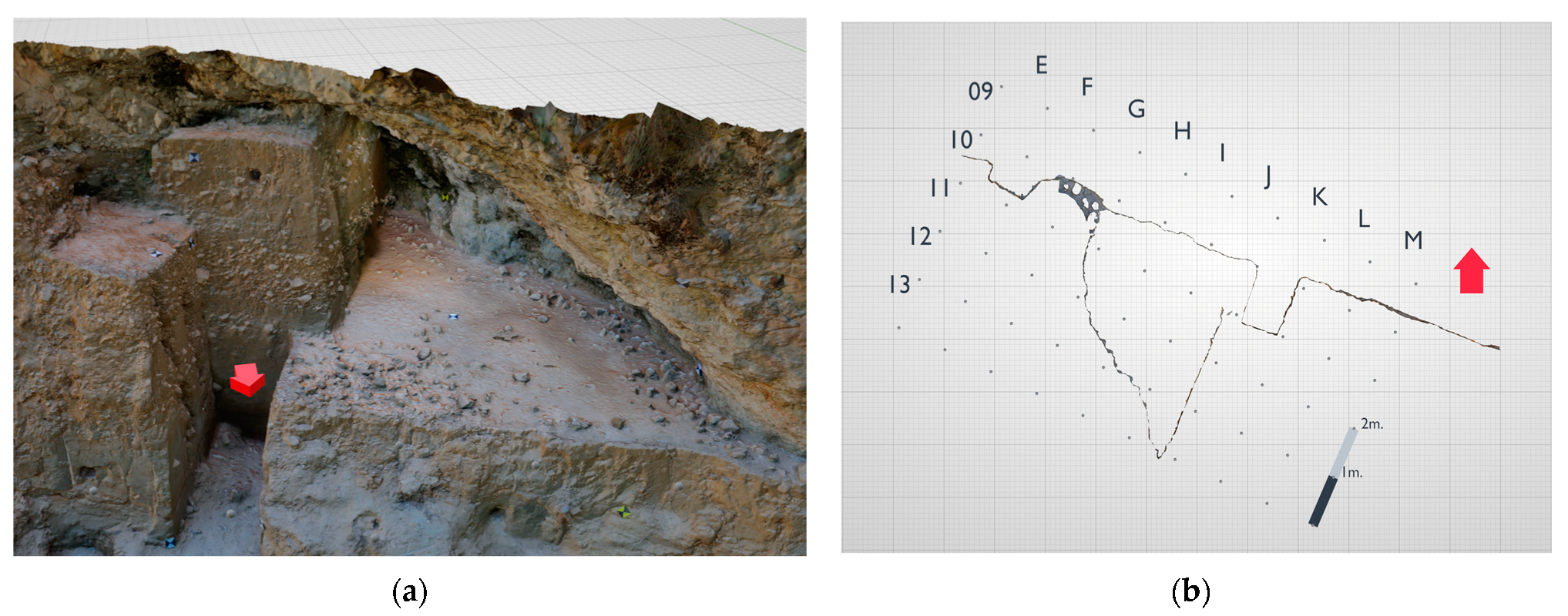

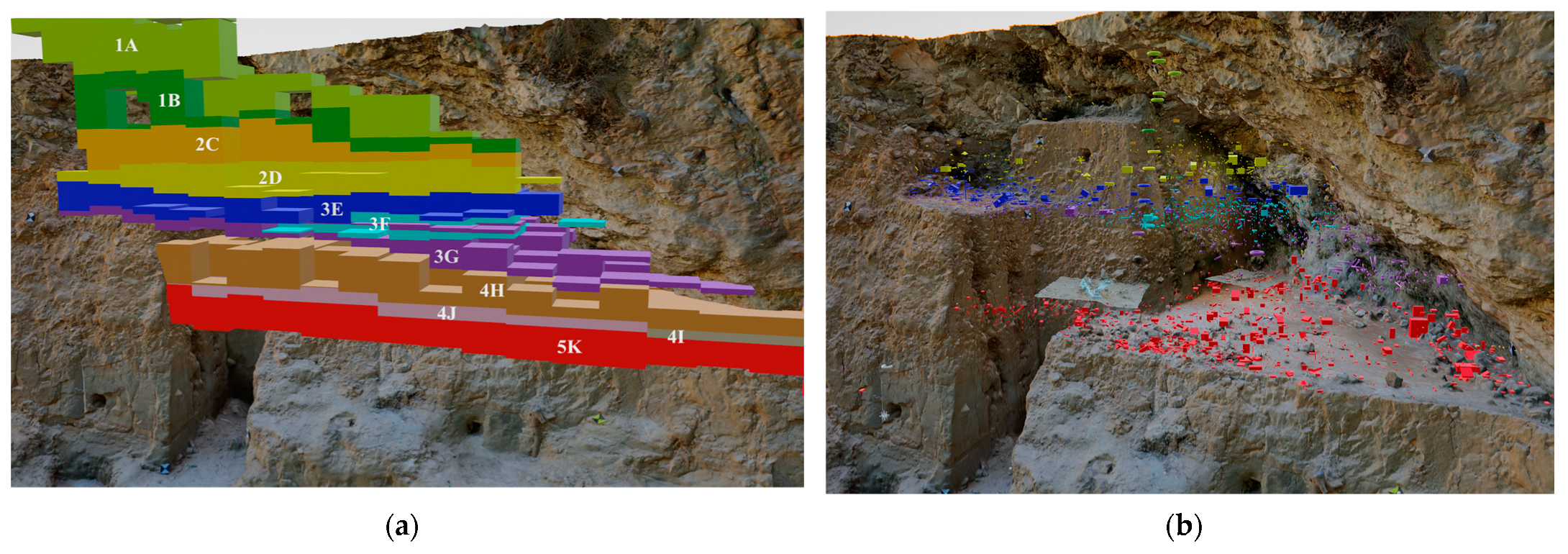

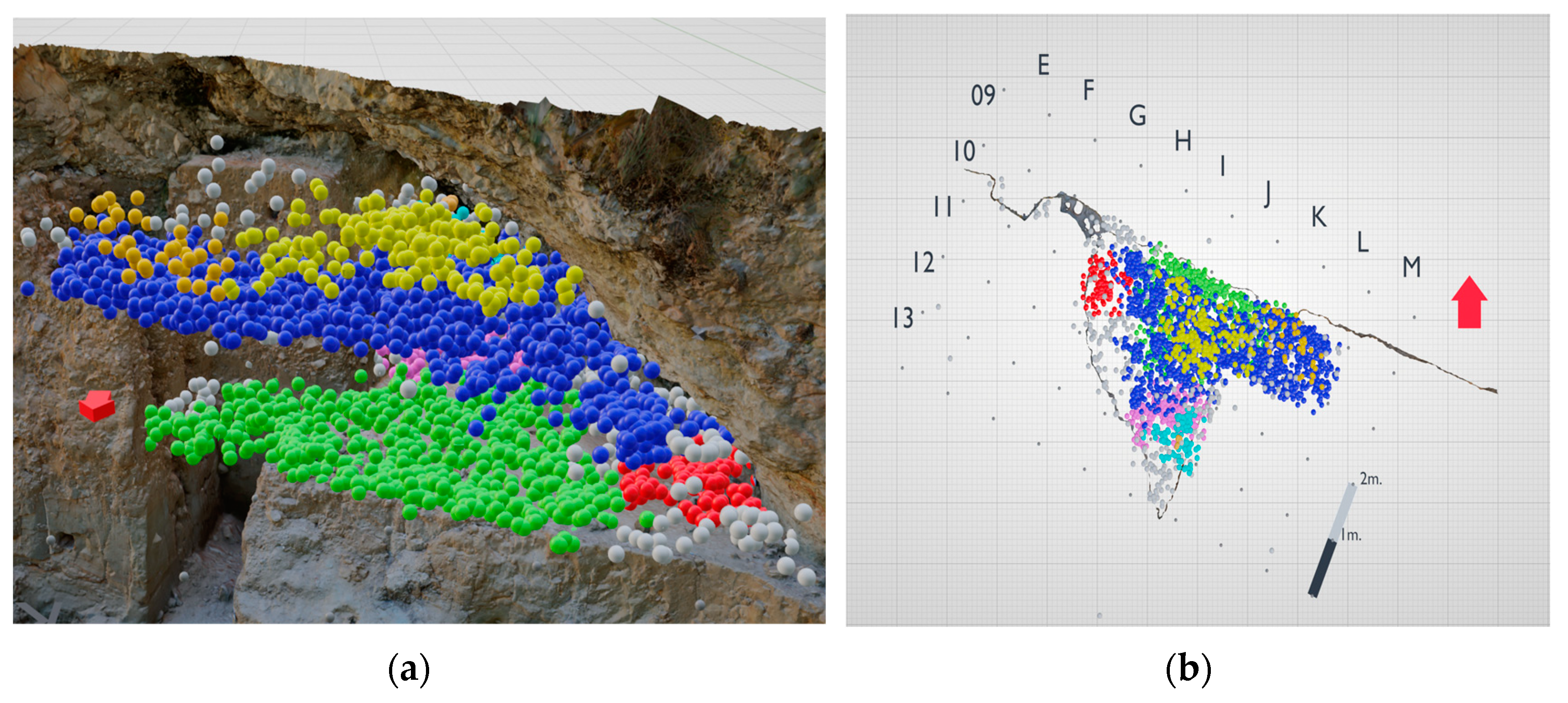




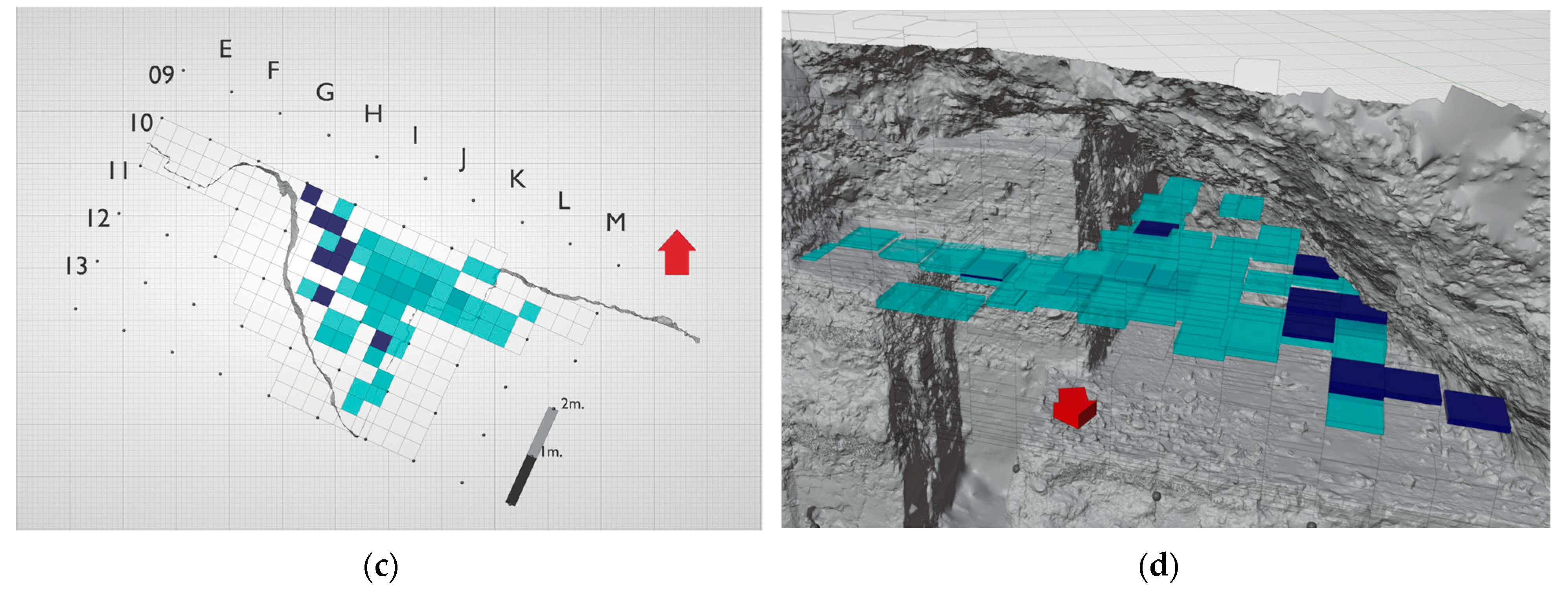


| Level | Layer | Features |
|---|---|---|
| 1 | A, B | It included modest vertebrate evidence. |
| 2 | C, D | It comprised small and large vertebrate remains, as well as evidence of the lithic industry associated with the Mousterian technocomplex. |
| 3 | E, F, G | It encompassed extensive deposits of Mousterian lithic tools and various animal remains, including small and large specimens. |
| 4 | H, I, J | It was archaeologically unfertile. |
| 5 | K | It consisted of various small and large animal remnants and artefacts from the Mousterian lithic industry. It was the most prolific archaeological stratum found throughout the excavation. |
| Lithostratigraphic Unit | Date |
|---|---|
| 2D | 43,397 ± 1446 Cal BP (AMS) |
| 3G | 42,880 ± 1714 Cal BP (AMS) |
| 45,800 ± 3500 Cal BP (OSL) | |
| 5K | 46,400 ± 5900 Cal BP (AMS) |
| Categorical Variable | Values |
|---|---|
| Retouched tool | Retouched, pseudo-retouched. |
| Reduction sequence stage (% cortex) | Products entirely made by cortex (100%), products with much cortex (75–99%), products with cortex (50–74%), products with little cortex (25–49%), product with almost no cortex (1–24%), products without cortex (0%). |
| Volume/type of product | Residual fragments [debris] (x < 30 mm3), lithic products (30 mm3 < x < 700 mm3), (700 mm3 < x < 1200 mm3), (1200 mm3 < x < 5000 mm3), (5000 mm3 < x < 20,000 mm3), (x > 20,000 mm3), cores, hammer/cobbles. |
| Raw material (a combination of the stone colour and type) | Brown jasper, white quartz, brown Otero flint, honey-coloured Otero flint, grey flint, grey Otero flint, translucid grey Otero flint, grey granodiorite, grey/white Otero flint, black sardonyx, translucid Otero flint, honey-coloured flint, white Otero flint, grey diorite, green jasper, grey/blue Otero flint. |
| Knapping characteristics (blend of butt—bulb—dorsal surface): Butt: without, flat, cortical, dihedral, punctiform. Bulb: pronounced, little pronounced, not pronounced. Dorsal surface: indeterminate, unipolar, unipolar convergent, centripetal. | Flat—little pronounced—indeterminate (FLPI), flat—not pronounced—indeterminate (FNPI), flat—pronounced—indeterminate (FPI), without butt—without bulb—indeterminate (WWI), flat—pronounced—unipolar convergent (FPUC), flat—little pronounced—unipolar convergent (FLPUC), flat—not pronounced—unipolar convergent (FNPUC), cortical—not pronounced—indeterminate (CNPI), punctiform—not pronounced—indeterminate (PNPI), flat—pronounced—unipolar (FPU), dihedral—pronounced—indeterminate (DPI), flat—little pronounced—centripetal (FLPC), flat—not pronounced—centripetal (FNPC), flat—pronounced—centripetal (FPC). |
| Categorical Variable | Values |
|---|---|
| Taxon/animal size | Mustelid, fox, bovid, small bovid, equine, cervid, carnivore, capreolus, goat, rabbit, very small, small, medium, big/medium, big, very big. |
| Anatomical part | Rib, cranium, tooth, phalanx, femur, humerus, jaw, sesamoid, tibia, vertebra. |
| Type of fracture1 | Fresh/fresh, fresh/indeterminate, fresh/modern, fresh/dry, indeterminate/indeterminate, indeterminate/modern, modern/modern, dry, dry/indeterminate, dry/modern, dry/dry. |
| Type of mark | Cut, teeth, percussion, trampling. |
| Age | Infant, juvenile, adult, senile. |
| Categorical Variable | Values |
|---|---|
| Thermo-alterations | Lithic thermo-alteration, white-colour faunal alteration, cream-colour faunal alteration, black-colour faunal alteration. |
| CDC [17] | DBSCAN [15] | HDBSCAN [14] | OPTICS [16] |
|---|---|---|---|
| Clustering algorithm for data with heterogeneous density and weak connectivity. | The algorithm groups densely packed points (those with numerous adjacent neighbours) and highlights points isolated in low-density zones (those whose closest neighbours are excessively distant). | This hybrid clustering technique identifies collections within datasets by analysing the density distribution of data points. Compared to other clustering algorithms, this approach does not require the pre-specification of the number of clusters. | OPTICS produces an ordering clustering outcome based on a changeable neighbourhood radius (reachability distance). Users are not required to specify a density threshold, but they can adjust it [Figures S6–S12]. |
| Lithostratigraphic Unit | Volumetric Proportion |
|---|---|
| 1A | 04.41% |
| 1B | 02.55% |
| 2C | 05.57% |
| 2D | 08.79% |
| 3E | 08.22% |
| 3F | 06.49% |
| 3G | 11.73% |
| 4H | 18.10% |
| 4I | 03.39% |
| 4J | 07.14% |
| 5K | 23.61% |
| Lithostratigraphic Unit | Faunal Categories | Faunal Variables | Lithic Categories | Lithic Variables |
|---|---|---|---|---|
| Entire excavation | Taxon, age, anatom. part. | Carnivore, senile, phalanx, sesamoid. | Volume, material, reduction. | x < 700 mm3, x > 20,000 mm3, brown jasper, non-cortex, brown Otero flint. |
| 2D | Fracture, taxon, anatom. part, age. | Femur, tibia, fresh/indet., big and small species, infant. | Material, reduction, volume, knapping. | x > 20,000 mm3, much cortex, brown Otero flint, 1200 mm3 < x < 20,000 mm3, FPI. |
| 3E | Fracture, anatom. part, taxon, mark. | Femur, Equus sp., small sp., dry, tibia, tooth mark. | Volume, material, reduction, knapping. | x > 20,000 mm3, brown jasper, honey Otero flint, all-cortex, 30 mm3 < x < 700 mm3, FPC, non-cortex. |
| 3F | Taxon, thermoalt., anatom. part, fracture. | Bos, humerus, big and small sp., cream and black alt., fresh/fresh. | Knapping, volume, material, retouch. | FLPI, pseudo-retouch, FPU, grey flint, 700 mm3 < x < 5000 mm3. |
| 3G | Taxon, anatom. part, fracture, age. | Juvenile, tibia, phalanx, dry/dry, Equus sp., Capreolus sp. | Volume, material, knapping, reduction. | x > 20,000 mm3, FLPI, much cortex, honey Otero flint, 700 mm3 < x < 1200 mm3. |
| 5K | Taxon, age, anatom. part [Figure S17]. | Senile, carnivore, phalanx, Equus sp., cut mark [Figures S18 and S19]. | Volume, material, reduction, knapping [Figure S20]. | x < 700 mm3, all cortex, honey flint, non-cortex, FLPI, 1200 mm3 < x < 20,000 mm3 [Figure S21]. |
| Correlations | GNN Diagrams | |
|---|---|---|
| UNIT 1A (2 artefacts) | ||
| Sterile. | ||
| UNIT 1B (5 artefacts) | ||
| Sterile. | ||
| UNIT 2C (55 artefacts) | ||
| There is a slight presence of quartz, brown jasper, and black sardonyx fragments. Fresh/modern bone fractures, as well as hammer or cobblestone fragments, have a moderate prevalence. There is a discernible presence of cut marks and juvenile faunal rests. There are no evident connections among these elements. | ||
| UNIT 2D (457 artefacts) | Threshold 46% | Threshold 40% |
| 1. An interconnection between white quartz and residual fragments (debris). 2. A relationship between the non-cortex lithic industry and tiny flakes (30 mm3 < x < 700 mm3). 3. An association between very big-sized animal rests and dry fractures. 4. A connection between tibia remains and fresh/indeterminate fractures. 5. A presence of core lithic pieces associated with dry fractures. | 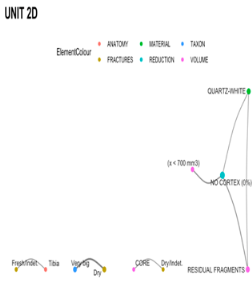 | 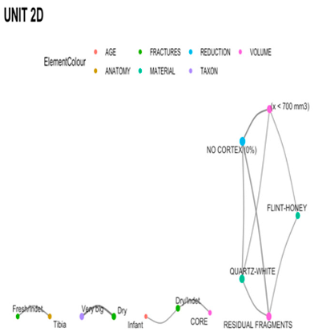 |
| UNIT 3E (603 artefacts) | Threshold 46% | Threshold 40% |
| 1. A looped link between non-cortex stones, grey flint, and small flakes (30 mm3 < x < 700 mm3). 2. A relationship between white quartz and small flakes (30 mm3 < x < 700 mm3). 3. A correlation between adult faunal rests and non-cortex stones. 4. An association between lithic industry (1200 mm3 < x < 5000 mm3) and non-cortex traits. 5. A connection of grey diorite with residual fragments (debris) and all-cortex stones. 6. A tie between honey-coloured Otero flint, residual fragments (debris), and medium-sized lithic industry (700 mm3 < x < 1200 mm3). 7. A presence of core lithic pieces associated with some cortex (75–50%). |  | 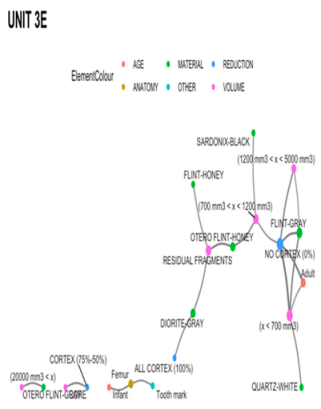 |
| UNIT 3F (506 artefacts) | Threshold 46% | Threshold 40% |
| 1. An association among black-coloured thermo-alterations and adult faunal remains. 2. A relationship between big/medium-sized animals and humerus remnants. |  | 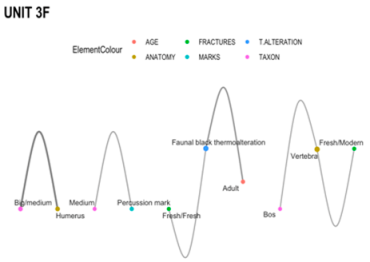 |
| UNIT 3G (993 artefacts) | Threshold 46% | Threshold 40% |
| 1. An association among black-coloured thermo-alterations and adult faunal remains. 2. A correlation between grey flint and a flat butt, pronounced bulb, and unipolar dorsal (FPU) flaking. 3. A connection between cut marks, the Equus genus rests, and fresh/indeterminate fractures. 4. A linkage between big-sized faunal rests with percussion marks. | 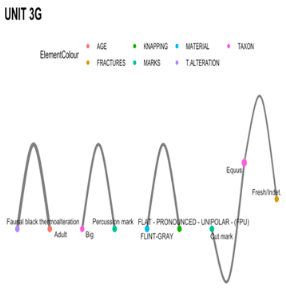 |  |
| UNIT 4H (32 artefacts) | ||
| The tibia and humerus bones are present in small quantities. There is a moderate amount of brown Otero flint, honey-coloured Otero flint, and stones with much cortex (99–75%). There is an accumulation of residual fragments and a medium-sized lithic industry (1200 mm3 < x < 5000 mm3). There are no patent correlations between the components mentioned above. | ||
| UNIT 4I (1 artefact) | ||
| Sterile. | ||
| UNIT 4J (5 artefacts) | ||
| Sterile. | ||
| UNIT 5K (1531 artefacts) | Threshold 46% | Threshold 40% |
| 1. A robust correlation among vertebra, sesamoid, and phalanx bones in connection with senile carnivore rests (Canis lupus) and fresh/modern, indeterminate/indeterminate fractures. 2. A solid association between a flat butt, little pronounced bulb, and indeterminate dorsal (FLPI) flaking connected with non-cortex brown Otero flint, brown jasper, and white quartz with volumes that vary from 30 mm3 to 20,000 mm3. 3. A firm tie between some-cortex (75–50%) stones connected with (1200 mm3 < x < 20,000 mm3)-sized lithic industry. 4. A steady relationship between small flakes (30 mm3 < x < 700 mm3) and a flat butt, pronounced bulb, and indeterminate dorsal (FPI) flaking. 5. A robust correlation between a flat butt, non-pronounced bulb, and indeterminate dorsal (FNPI) flaking with (1200 mm3 < x < 5000 mm3) lithic size. |  |  |
| Total: 4190 artefacts in the excavation | 134 connections achieved (0.3%) | 205 connections achieved (0.47%) |
| Lithostratigraphic Unit | Degree of Centrality | Central Node | Betweenness Centrality | Closeness |
|---|---|---|---|---|
| 2D | 38 No cortex (0%), 24 Residual fragment. | No cortex (0%). | No cortex. |
|
| 3E | 62 No cortex (0%), 44 30 mm3 < x < 700 mm3. | No cortex (0%). | No cortex. |
|
| 3F | 12 Humerus, 12 Big/medium-sized. | Humerus/big-medium-sized. | - |
|
| 3G | 44 Equus sp., 26 Adult. | Equus sp. | Equus sp. |
|
| 5K | 324 Senile, 320 Carnivore. | Senile. | 1200 mm3 < x < 5000 mm3. |
|
| Lithostratigraphic Unit | Degree of Centrality | Central Node | Betweenness Centrality | Closeness |
|---|---|---|---|---|
| 2D | 38 No cortex (0%), 32 Residual fragment. | No cortex (0%). | Residual fragment. |
|
| 3E | 74 No cortex (0%), 56 30 mm3 < x < 700 mm3. | No cortex (0%). | 30 mm3 < x < 700 mm3. |
|
| 3F | 18 Faunal black alter., 16 Vertebra. | Faunal black alter. | Faunal black alter. |
|
| 3G | 82 Adult, 82 FPU. | Adult/FPU. | Big/medium-sized. |
|
| 5K | 380 Senile, 376 Carnivore. | Senile. | Brown jasper. |
|
Disclaimer/Publisher’s Note: The statements, opinions and data contained in all publications are solely those of the individual author(s) and contributor(s) and not of MDPI and/or the editor(s). MDPI and/or the editor(s) disclaim responsibility for any injury to people or property resulting from any ideas, methods, instructions or products referred to in the content. |
© 2024 by the author. Licensee MDPI, Basel, Switzerland. This article is an open access article distributed under the terms and conditions of the Creative Commons Attribution (CC BY) license (https://creativecommons.org/licenses/by/4.0/).
Share and Cite
Dilena, M.Á. Working in Tandem to Uncover 3D Artefact Distribution in Archaeological Excavations: Mathematical Interpretation through Positional and Relational Methods. Heritage 2024, 7, 4472-4499. https://doi.org/10.3390/heritage7080211
Dilena MÁ. Working in Tandem to Uncover 3D Artefact Distribution in Archaeological Excavations: Mathematical Interpretation through Positional and Relational Methods. Heritage. 2024; 7(8):4472-4499. https://doi.org/10.3390/heritage7080211
Chicago/Turabian StyleDilena, Miguel Ángel. 2024. "Working in Tandem to Uncover 3D Artefact Distribution in Archaeological Excavations: Mathematical Interpretation through Positional and Relational Methods" Heritage 7, no. 8: 4472-4499. https://doi.org/10.3390/heritage7080211
APA StyleDilena, M. Á. (2024). Working in Tandem to Uncover 3D Artefact Distribution in Archaeological Excavations: Mathematical Interpretation through Positional and Relational Methods. Heritage, 7(8), 4472-4499. https://doi.org/10.3390/heritage7080211







